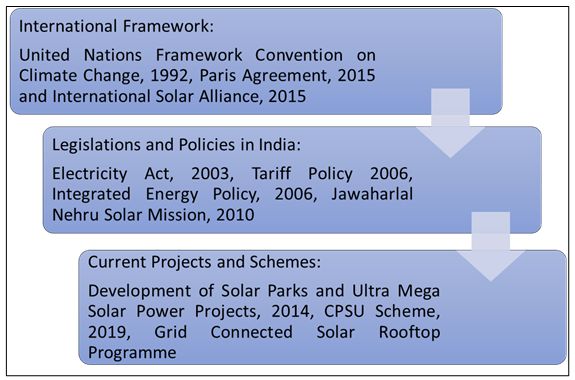Introduction
The International Solar Alliance (ISA or Alliance) was launched as a joint effort by India and France at the United Nations Climate Change Conference in 2015 in Paris (COP 21). The initiative was first proposed by the Prime Minister of India on November 2015 in the UK, where he referred to sunshine countries as Suryaputra (Sons of the Sun).
The framework agreement of ISA opened for signatures in Marrakech, Morocco, in November 2016 on the sidelines of the Climate Conference (COP-22).
The 123 signatory countries – sunshine countries lying between the Tropic of Cancer and the Tropic of Capricorn, came together to form the ISA. It is a platform that works to create and implement solar-powered energy solutions to assist member states in pursuing low-carbon growth trajectories. The ISA is focused particularly on Least Developed Countries and the Small Island Developing States.
For a contextual understanding of the ISA, please refer to our article titled, 'Growth of Solar Power in India'.

About ISA
ISA is headquartered in Gurugram, Haryana (India). In January 2016, the Hon'ble Prime Minister of India, Shri Narendra Modi, and then French President Francois Hollande jointly laid the foundation stone of the ISA headquarters and thereby inaugurated the interim secretariat for the National Institute of Solar Energy (NISE). The Indian government dedicated 5 acres of land on the NISE campus for its future headquarter and contributed USD 22m to the fund to build a campus and meet the expenditure for the first five years. The ISA is also known as the International Agency for Solar Policy and Application.
Objective of ISA
The objective of ISA is to bring together nations in efforts to endorse clean energy, a sustainable environment, public transport, and climate. There are a total of 128 member nations in the alliance.
The focus is on solar power utilization. The launch of the Alliance in Paris does send a strong signal to the global community about the sincerity of the developed nations towards their concern for climate change, and the efforts to switch to a low-carbon growth path. The area of Earth located between the Tropic of Cancer and the Tropic of Capricorn is called the Tropical (Torrid) zone. In this part of the earth, the sun may appear directly overhead, enabling greater solar exposure. The more direct exposure results in a greater effect of the sun here; anywhere north or south of this zone, sunlight always reaches the earth's surface at an angle and is correspondingly less intense. For India, possible additional benefits from the alliance can be
strengthening ties with the major African countries and increasing goodwill for India among them.
India, supported by France, has invited nations to facilitate infrastructure for the implementation of the solar project. The Alliance has committed 1 trillion dollars in investment. It aims to reduce the costs of solar power to make it affordable for remote and inaccessible communities. The Alliance has entered into an understanding with the World Bank for the mobilization of solar energy.
ISA member countries are located across Africa, Asia-Pacific, Latin America, and Europe. The development of large-scale solar generation capacity in various regions and the development of bilateral, regional, and interregional transmission interconnections have the potential to eventually lead to the global interconnection of solar energy resources and solar energy transfer from one part of the world to another.
One Sun, One World, One Grid
A discussion on the ISA and its goals and role of India would be incomplete without reference to the One Sun One World One Grid (OSOWOG) initiative. The OSOWOG initiative was proposed by the Hon'ble Prime Minister of India, Shri Narendra Modi, at the First Assembly of the ISA in October 2018. The vision is to connect energy supply across borders, which could be possible because the 'sun never sets'.
GGI – OSOWOG
The Green Grids Initiative – OSOWOG was launched jointly by the Hon'ble Prime Minister of India, Shri Narendra Modi and the, then, Hon'ble Prime Minister of United Kingdom, the Rt Hon. Boris Johnson, during the 'Accelerating Innovation and Clean Technology Deployment' event at the World Leaders Summit held on 2 November 2021 during COP26.
Further, the 'One Sun Declaration' which was approved by the 4th Assembly of the ISA was also launched at this time.
World Resources
We exist because the Planet is a balanced system as a whole irrespective of the geographical boundaries demarcated by humans.
Various constituents are interdependent and balance each other globally to make Earth habitable.
The primary source of energy, The Sun, is available to and shared by all and so is Wind, Rain, Subterrestrial energy, etc.
Such is the distribution of nature and so is the responsibility.
It seems only logical that the concept of sustainable development can be viewed only at a global level and can be achieved by individual and collective effects of all nations.
Sources: Author's Experience
Citation: This Insight may be cited as InfEneTy 'International Solar Alliance – Paving Way for Sharing World Resources' 22.06.2023
Originally published by InfEneTy
The content of this article is intended to provide a general guide to the subject matter. Specialist advice should be sought about your specific circumstances.


